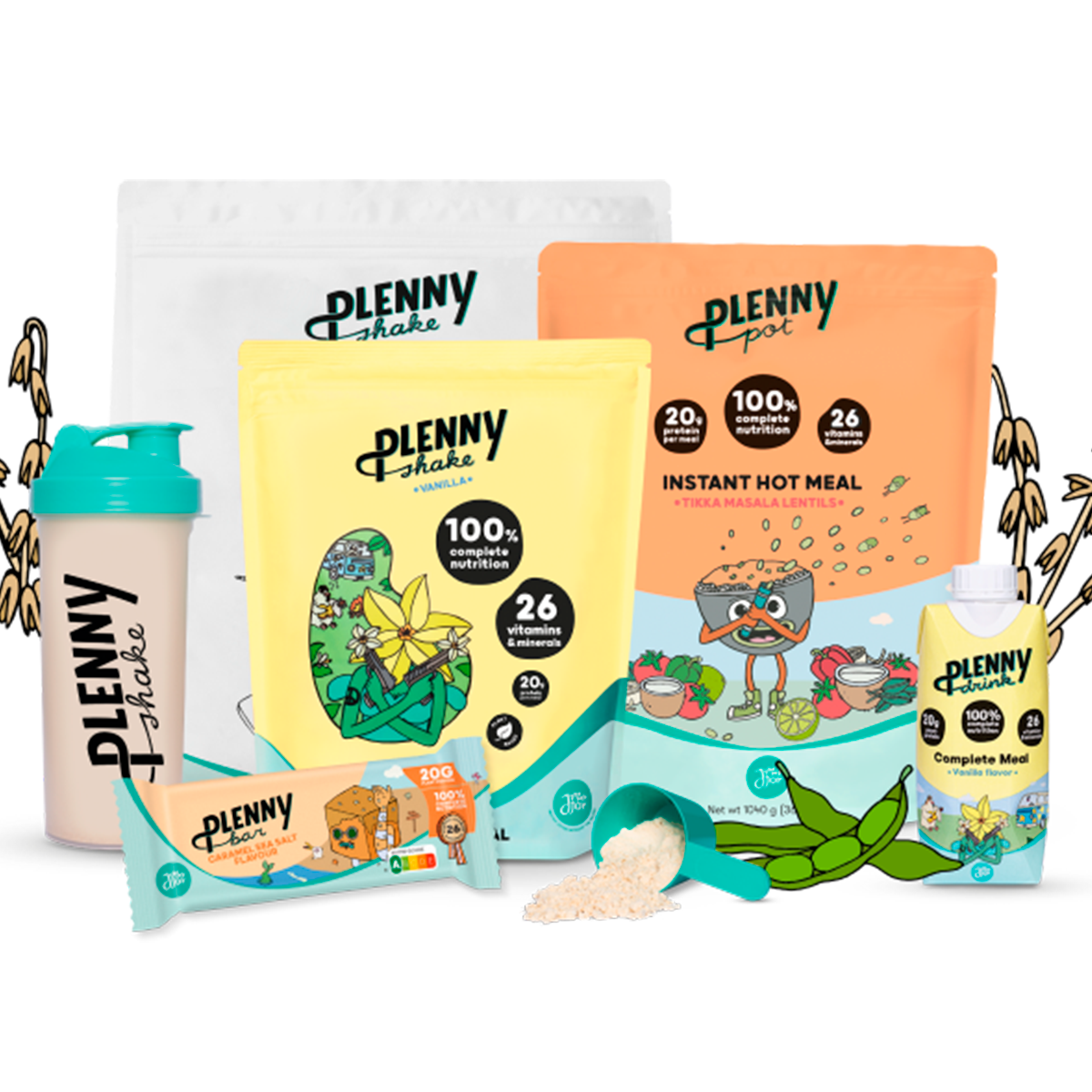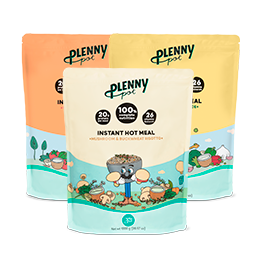Earth Overshoot Day

Have you ever heard of World Overdrive Day? It's one of those days you wish never existed. Like Valentine's Day, but worse. However, it's important to address the harder things in life too, so let's dive into it.
This article will explain what World Overcoming Day means and how it is calculated, its relation to the food industry, how we can push back the date, and Jimmy Joy's role in it all.
What is Earth Overshoot Day?
World Earth Overshoot Day, also known as "Ecological Debt Day," is the day when humanity's demand for Earth's natural resources exceeds its capacity to regenerate this demand throughout the year. Overwhelming much? Indeed it is.
In short, from that day until the rest of the year we live in debt to our planet .
Imagine a hypothetical scenario where you only get paid once a year on January 1st, and that amount has to last you the whole year. Now imagine that by August 22nd your account balance equals zero, but you still have like 4 months before you get paid again. So now you have to borrow from next year's fund, and the next year, and the year after that. It's a vicious cycle. Doesn't sound too good, does it?
So let's reconsider some of our habits and stop the cycle!
Let's start with some facts.
In 2020, Overshoot Day fell on August 22nd . Wondering what that means? Here's a quick rundown:
1970: December 29
1985: November 4
2000: September 23
2015: August 6
2018: August 1st
2019: July 29
2020: August 22 **
Quick math: it's bad, but not as bad as it was 5 years ago*. But still, the last time we nearly avoided overshoot was in the 1970s.
And if you're curious to know what your personal overshoot day is and how much you contribute to the ecological footprint, you can use The Global Footprint Network's personal overshoot date calculator . By answering a few short questions, you can see "how many planet Earths we would need if everyone lived like you." (1)
*Side note: The impact of the economic slowdown due to the COVID19 situation, led to a reduction in humanity’s ecological footprint and thus helped a lot in moving the Overshoot Day to a later stage. For instance, The Global Footprint Network claims that the drop in carbon emissions due to the coronavirus resulted in a 14.5% reduction in the carbon footprint.
**Side note to side note: The shift from 2019’s overcapacity day on July 29 to August 22, 2020 represents the largest single-year change since the beginning of global overcapacity in the early 1970s. And experts say we can thank the impact of COVID19 for that. They say look for the positive in every situation, don’t they?
How is World Overcapacity Day calculated?
The Global Footprint Network is an organization that calculates the date of World Overshoot Day each year. It is calculated by dividing the planet's biocapacity (the amount of ecological resources the Earth is capable of generating that year, or more specifically, all the biologically productive spaces needed to regenerate global demand) by the Ecological Footprint of humanity (humanity's demand in that year) and multiplying by 365 days:
(Earth's Biocapacity / Humanity's Ecological Footprint) x 365 = Earth Overcome Day)
The Global Footprint Network also came up with a movement known as #movethedate , proposing numerous solutions to do so. They suggest five main areas for humanity to improve our sustainability practices:
- cities
- energy
- meal
- planet
- population
You can read more about them here ; but since we operate in the food industry, we will focus primarily on the food aspect.
Food and its impact on World Overcapacity Day
Food, as one of the most essential means for humanity’s survival, is also one of the main contributors to the production of the ecological footprint. Therefore, the way we source, produce, consume and dispose of food are powerful actions that influence sustainability and, in essence, lead to moving the Earth’s overshoot date.
The Global Footprint Network states that food demand accounts for almost one-third of the ecological footprint . It can be argued that two main issues in addressing food sustainability relate to resource efficiency and food waste (2).
We can also recognize that the COVID19 situation strongly affected the food system, however, it is believed that significant changes regarding the food footprint cannot be explained.
Hey, but how?
During the lockdown, many public places (including restaurants, offices, schools, etc.) were closed. Therefore, people ate at home more often and therefore produced less food waste. However, on the production side, excess demand has offset this, as processing plants and farms experienced a huge increase in food waste.
National Geographic recently published an extremely interesting article on the future of food, which addresses the issue of global population growth. As you may or may not have heard before: the world's population will reach 10 billion by 2050 (3). "Increasing food production while respecting human well-being and the environment presents enormous challenges." (4)
So, for example, with the population increasing by 35% by 2050, to feed the world, crop production will need to double.
Why is that?
Because the consumer middle class is expanding, bringing with it increased demand for resource-intensive animal foods. And because currently, 30-50% of our food is wasted in the supply chain or at consumption. This amount could feed another 3 billion people.
1 in 4 of the calories we create are never consumed by humans. Especially with resource-intensive foods like beef, every 25-30 calories fed to a cow produces only 1 calorie of meat. The rest of the calories are wasted on utilizing the animals to produce parts that end up not even being used for human consumption (5). Or compared to oats, which is our main ingredient: for every 100 calories of oats eaten by animals, they produce only 12 calories of chicken, 3 calories of beef, 22 calories of eggs, and 40 calories of milk. So imagine how much more calorie-efficient it is when humans consume oats directly. That’s why it’s our main ingredient!
The sad part is that it's not just about wasted calories. Compared to growing human edible crops, meat production requires a significantly larger amount of land (i.e. the Earth's biocapacity) and therefore contributes to a much larger carbon footprint, water pollution, and physical waste, among others.
With all this in mind, it is no wonder why every major report addressing the issues of feeding 10 billion people by 2050 concludes that a drastic shift towards plant-based food alternatives is imperative (e.g. WRI 2019 ).
Rethinking the food pyramid
If you're like us, a more visual type, then you should check out this cool pyramid we drew for you. So, do you know your traditional food pyramid, the one you might remember from elementary school?
The Barilla Food and Nutrition Center has updated it to the double food pyramid, which you can see just below this paragraph. It simultaneously assesses the impact a given food has on both human health and the environment. What you can see is that the foods at the base of the pyramid, recognized as healthier by health experts and nutritionists, are actually also the best for the planet. So, it's a win-win.

And the best part is that the individual-level solutions that food experts propose are extremely tangible for each of us. Starting today, it may mean simply pouring oat milk instead of cow's milk into your morning coffee, or replacing ground beef with lentils in tonight's bolognese sauce. Or simply enjoying your Jimmy Joy products .
How the global overcapacity date can be moved along with Jimmy Joy
As mentioned, the Food Footprint component consists mainly of two elements: resource efficiency and food waste .
According to The Global Footprint Network, it is believed that if we cut meat consumption in half and replaced it with plant-based foods, the overshoot date would move 5 days.
Furthermore, food waste is currently 1.3 billion tonnes each year, or one third of all global production; if we halve it, World Overshoot Day would move 13 days (2).
So what can we do?
Eat more plant-based
Not to repeat ourselves, but yes, we are vegan. Plus, our product shelf life is 12 months and our products are extremely easy to store (click here for more tips on reducing food waste). Wait, did we practically solve the overshoot problem? 5+13=18. Did we just move the date 18 days? Now all we have to do is add them all up. But that should be easy, right? Shop Jimmy Joy products here and let’s change the date together.
What is Jimmy Joy doing to delay the date?
First of all, because we want everyone to share our joy, we aim to be available in as many countries as possible. But we are also aware that shipping abroad contributes to the creation of a carbon footprint. However, transport is actually a very small part of the food footprint. Less than 10% for most foods. So even the most sustainable animal products are much less sustainable than transported plant products.
But we don’t just want to hold on to that, we want to be even better, so we partnered with the non-profit foundation Trees4all , who helps us neutralize our carbon footprint by planting trees in Bolivia. We chose to pursue carbon offsetting to help contribute to the restoration of ecosystems and biodiversity and do our part to give back to society, while still being widely available to our consumers around the world.
Secondly, our R&D team is continuously working to improve our product formulas and seeks out suppliers who are as transparent as possible in their sustainability efforts. One of the examples of our most recent product improvements was the replacement of the omega-3 source. After extensive research to create a fully vegan product, we found Ahiflower, which is the best sustainable plant-based alternative that provides additional omega 3 and omega 6 fatty acids for your immune system. For example, 1 acre of Ahiflower produces as much omega-rich oil as 40,000 mackerels or sardines. And since approximately 25 million tons of wild fish are used in oil production every year, we are very proud to say that we are winning the sustainability race (6).
Thirdly, we would like to say that we consider ourselves the food of the future , safeguarding the intake of essential micronutrients and contributing to important environmental benefits. But we are always open to improvements and suggestions on how we can do even better.
Sources
- Earth Overshoot Day. (2020). About Earth Overshoot Day .
- Earth Overshoot day. (2020). Food .
- Foley, J. (n.d.). Five Step Plan to Feed the World .
- World Resources Institute. (2019). Creating a Sustainable Food Future.
- Leahy, S. (2019). How to feed the world without destroying the planet .
- Ahiflower. (2020).





















